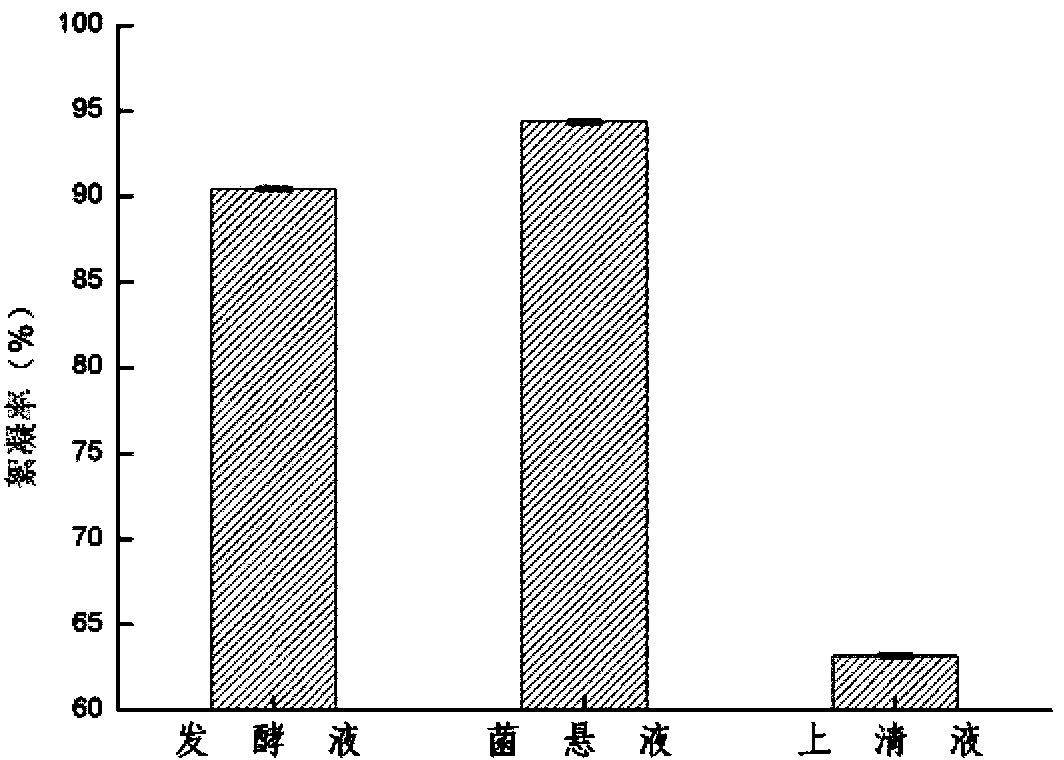Enterobacter gergoviae and its use in bioflocculation
A microbial flocculant, enterobacteriaceae technology, applied in the field of microorganisms, can solve the problem of no enterobacteriaceae and achieve good pH stability, short flocculation time and high efficiency
- Summary
- Abstract
- Description
- Claims
- Application Information
AI Technical Summary
Problems solved by technology
Method used
Image
Examples
Embodiment example 1
[0042] Implementation Case 1 Screening and identification of high-efficiency flocculation bacteria
[0043]The flocculation strains were screened from activated sludge and landfill leachate, and the isolated strains were respectively inserted into 250ml wide-mouthed Erlenmeyer flasks equipped with 50ml of seed culture medium (see Example 3 below), and placed in a shaker at 30 Cultivate at 200rpm for 24 hours, and take the culture solution to measure the flocculation rate. A strain of Enterobacter diazoae with the highest flocculation activity was obtained, its biological deposit number was CCTCC M2013042 strain, and it was named eth-2. and use it as the target for subsequent experiments.
[0044] Identification method: eth-2 such as figure 1 As shown, through 16S rRNA sequencing (the sequencing result is shown in SEQ ID NO: 1) and compared in NCBI, the similarity with Enterobacter.Gergoviae (AB682278.1) reached 99%.
Embodiment 2
[0045] The preparation of embodiment 2 culture medium
[0046] 1. Culture medium preparation
[0047] 1. Solid plate medium: tryptone, 10.0g; yeast powder, 5.0g; NaCl, 10.0g; agar powder, 20.0g; distilled water, 1L.
[0048] 2. Seed medium: glucose, 10.0g; K 2 HPO 4 , 5.0g; MgSO 4 ·7H 2 O, 0.2g; KH 2 PO 4 , 2.0g; NaCl, 0.1g; urea, 0.5g; yeast powder, 0.5g; distilled water 1L.
[0049] 3. Fermentation medium: glucose, 10.0g; K 2 HPO 4 , 5.0g; MgSO 4 ·7H 2 O, 0.2g; KH 2 PO 4 , 2.0g; NaCl, 0.1g; sodium nitrate, 1.0g; distilled water 1L.
[0050] Second, the culture and fermentation conditions of microorganisms:
[0051] The culture conditions of the solid plate medium: the eth-2 strain was inoculated in the solid medium and cultured at 30°C for 1 day, and then stored in a refrigerator at 4°C after being matured.
[0052] The cultivation conditions of the seed medium: the seed medium was sterilized at 115°C for 20 minutes, and then inserted into the strains of the s...
Embodiment example 3e
[0056] Implementation case 3eth-2 as preparation of microbial flocculant
[0057] 1. Centrifuge a certain volume of culture medium at 8000rpm and 5minl to collect the supernatant and precipitate respectively, and wash the precipitate with distilled water for 3 times and then resuspend it in a considerable volume of distilled water. Compare the supernatant, the precipitate suspension and the fermentation broth respectively The flocculation effect on kaolin to determine the distribution of flocculation activity. The result is as figure 2 As shown, the flocculation rates of the fermentation broth, bacterial suspension and supernatant were 90.45%, 94.36% and 63.20%, respectively, indicating that the flocculation activity of eth-2 was mainly distributed in the bacterial sediment, so the following experiments were used After repeated washing with distilled water for 3 times, the bacterial pellet resuspended in distilled water was used as a microbial flocculant.
[0058] 2. The ef...
PUM
 Login to View More
Login to View More Abstract
Description
Claims
Application Information
 Login to View More
Login to View More - R&D
- Intellectual Property
- Life Sciences
- Materials
- Tech Scout
- Unparalleled Data Quality
- Higher Quality Content
- 60% Fewer Hallucinations
Browse by: Latest US Patents, China's latest patents, Technical Efficacy Thesaurus, Application Domain, Technology Topic, Popular Technical Reports.
© 2025 PatSnap. All rights reserved.Legal|Privacy policy|Modern Slavery Act Transparency Statement|Sitemap|About US| Contact US: help@patsnap.com



